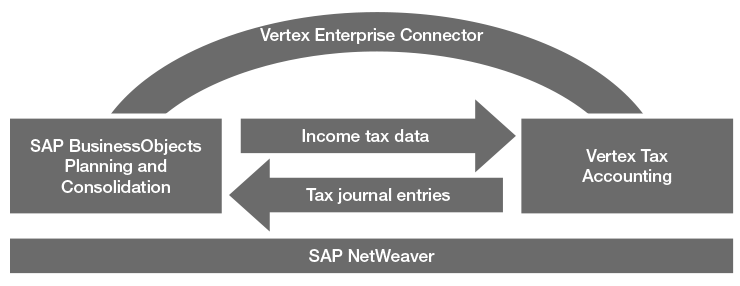Automating Income Tax Provisioning
How Automation and Connectivity Provide Greater Efficiency and Control Throughout the Tax Life Cycle
As digitization and globalization continuously increase the complexity of conducting business, a company’s performance depends on the strength of its technological connections. This of course applies to internal connections — such as integrating ERP systems with other point solutions — but it’s becoming increasingly important to also consider external systems — connecting the company’s technology with that of its customers and suppliers. This dynamic is especially true for tax technology: Without a direct link between financial data and the tax applications that use it, income tax processes across the tax life cycle are inefficient and susceptible to risk.
To avoid that risk, organizations must think about how they manage their trial balance data in order to optimize their accounting for income tax processes. By integrating tax solutions directly with SAP systems, companies can ensure tax data is communicated efficiently and accurately. Vertex Tax Accounting and the Vertex Enterprise Connector for SAP BusinessObjects Planning and Consolidation enable finance teams to cut down on time-consuming manual work and instead focus on value-added tax activities by automating tax processes and connecting tax solutions with companies’ ERP systems.
Increasing Complexity of Tax Reporting
The process of reporting current and deferred income taxes, also known as “provisioning,” is complicated and risk-laden in the best of circumstances. Most corporate tax departments operate under extremely challenging conditions due to the growing complexity of tax laws, the rising trend of global regulatory scrutiny, and rigid tax reporting deadlines.
Explore related questions
Today, tax reporting has become even more complex due to recent market trends. Companies are going global more than ever before, and with their desires for global growth, they are running into regulations from more countries. There is considerable consolidation activity, as companies look for organizations to acquire or merge with to capitalize on additional skills or specialties their rivals have. In doing so, they often need to combine, integrate, or even replace dozens of systems to ensure they are properly capturing tax data. And supply chains are now more far-reaching than ever, connecting with more partners in more places than ever, and requiring transparency and flexibility at every turn in order to adhere to tax laws.
Regulators require effective controls and increasing levels of transparency while a range of stakeholders — including investors, regulators, and management — expect tax functions to spontaneously share the tax effect of operational business information at any time. Tax departments must work with their internal and external finance and accounting partners to meet these new information demands while contending with multiple accounting standards, charts of accounts, currencies, and a host of related issues that create more intense data management challenges. These growing complexities mean that the tax life cycle has expanded to 365 days of the year, requiring tax departments to become more proactive as they work to meet these challenges.
The risk of failing to adequately clear these data management hurdles is particularly high in the income tax life cycle, where provisioning mistakes can lead to financial statement errors, regulatory enforcement actions, and potential repercussions from Wall Street. Fortunately, faster and more accurate tax performance management — that is, better automation and connectivity — can dramatically reduce provisioning challenges and risks. It is through the advanced data management capabilities that are available today that tax departments can fully achieve the goal of highly efficient income tax provisioning on a global scale.
Automating for Efficient Tax Provisioning
To address these mounting challenges in the tax provisioning space, Vertex — a corporate tax solutions provider — collaborated with SAP to simplify tax provisioning and deliver greater value to global tax departments with a new, SAP-integrated solution that equips users with automated tax provisioning functionality: the Vertex Enterprise Connector for SAP BusinessObjects Planning and Consolidation.
Certified to run on the SAP NetWeaver technology platform, the Connector integrates with SAP BusinessObjects Planning and Consolidation and enables automated provisioning using Vertex Tax Accounting. It moves trial balance data from SAP BusinessObjects Planning and Consolidation into the Vertex Tax Performance Engine, where it is tax-sensitized and then made available for use in Vertex Tax Accounting and the remaining downstream tax processes. The combination of the new Connector with this tax technology automates the collection and tax sensitization of data as well as the provision calculation process, all of which previously required manual data manipulation for SAP users. This means significantly less time has to be spent manually collecting income tax data and reconciling that data following the provision calculations when the process is supported by data from SAP BusinessObjects Planning and Consolidation.
Two key features of this solution enable users to efficiently navigate the complex world of income tax provisioning:
- While the solution transforms the financial data into tax-ready data, the source data in SAP BusinessObjects Planning and Consolidation is preserved exactly as it is to allow for efficient historical access
- The new Connector enables two-way data flow (see Figure 1). Vertex Tax Accounting automatically pulls the data needed for income tax provisioning from the SAP system, and then unifies, validates, and enriches it to produce provision calculations. Users can then write tax journal entries back into the SAP BusinessObjects Planning and Consolidation application to complete the provisioning process.

Learn More
As tax laws and regulations continue to change and evolve, tax professionals need to obtain the tools that will help them keep up. By directly connecting tax solutions with the data residing in finance systems, tax professionals can ensure that their calculations are based on clean and accurate data.
And, by introducing an automation solution such as the Vertex Enterprise Connector for SAP BusinessObjects Planning and Consolidation, tax professionals can significantly cut down on the manual effort that normally goes into collecting, sensitizing, and reconciling tax data. The two-way data flow between the Vertex solution and the SAP system reflects the nature of the companies’ ongoing relationship that has lasted for over 20 years, which depends on mutual understanding and collaboration to fuel continual improvements to customers’ tax data management capabilities.
To learn more about tax provisioning and how automation can help, visit www.vertexinc.com/solutions/income-tax-solutions/vertex-tax-accounting.






